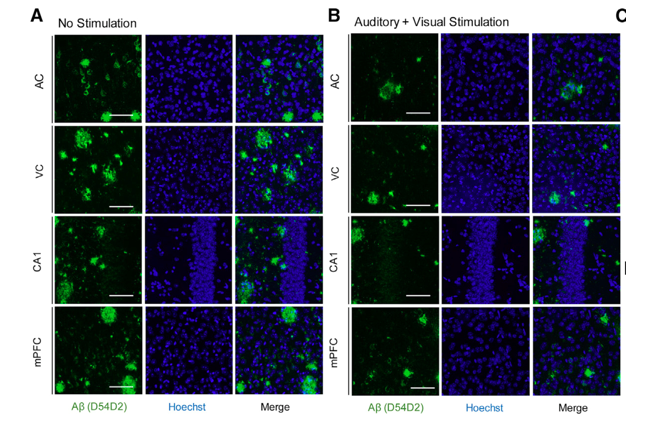If mouse models of Alzheimer’s disease had some cognitive functions restored by researchers exposing them to lights and sounds triggering gamma brain waves, would the same results happen in human studies?
The Warren Alpert Foundation is going to fund School of Psychology postdoctoral fellow Qiliang He $200,000 a year for the next two years to find out.
He, who is entering his fourth year at Georgia Tech, is the winner of an Warren Alpert Distinguished Scholar Fellowship Award to study how audiovisual stimulation modulating neural activity in the gamma range affects neural activity and cognitive function in humans.
“The whole study is actually an adaptation of animal studies,” He says. “The mice were exposed to gamma stimulation for one hour a day for eight weeks. We want to see if this similar intervention can work in humans.”
Mouse models refers to mice that have been genetically programmed to develop Alzheimer's disease pathology. "They have been altered to overexpress amyloid (plaques) and then develop other hallmarks of the disease like synaptic loss, brain atrophy, memory impairment, etc.," He says. His plans involve studying people who show the kinds of cognitive and memory declines found in normally aging adults first, and then expanding to conduct studies with Alzheimer’s patients. Because of the continuing pandemic, He hopes to start his in-person research in late summer.
In a 2019 study, MIT researchers, along with scientists from the Wallace H. Coulter Department of Biomedical Engineering and Emory University, found that light and sound stimulation targeting gamma waves reduce the buildup of amyloid plaques in the mice brains that modeled Alzheimer’s disease (AD) symptoms. Those plaques, or abnormal proteins, are what cause damage to brain grey matter. “Our observations demonstrate a non-invasive approach to elicit system-wide effects on AD-related pathology and improvements in cognition in an AD mouse model,” the authors wrote.
Gamma brain waves include a broad range of frequencies, from 30hz to 120hz. The sweet spot for this study appears to be 40hz, He says. “The gamma modulation is associated with learning and memory. In the aged population, and in patients with Alzheimer’s, this gamma optimization is abnormal, or is disrupted compared to healthy controls.” When gamma waves are activated, separate areas of the brain act more like a group. “It connects different brain regions together. It’s like a coordinator, getting different brain regions to communicate.”
The method to trigger those gamma waves, He explains, is deceptively simple: Subjects will view lights flashing and sounds turning on and off at 40 times per second (40hz.). He cites an earlier cohort study that followed a group of people who underwent the treatment for eight weeks, and it found no adverse effects due to the stimulation.
In addition to electroencephalograms (EEGs), functional magnetic resonance imaging (fMRI), and computational modeling, He will also use virtual reality to test his subjects’ spatial navigation ability. The loss of that ability is one of the earliest symptoms of Alzheimer’s, and of memory decline in an aging population, yet the mice in the MIT study showed rapid improvements after gamma wave treatment.
He is a postdoctoral fellow in Thackery Brown's lab in the School of Psychology and in Annabelle Singer's lab in the Coulter Department of Biomedical Engineering. He names both Brown and Singer as his mentors. Singer's lab co-led the 2019 study which He's work will build on.
Mark Wheeler, School of Psychology chair and professor, says after an internal Georgia Tech competition, He was put forth as the Institute's sole nominee for the Alpert Fellowship, which according to its website, “supports individual scientists of exceptional creativity who have an M.D. or Ph.D. degree (or both) and who have completed a minimum of three years of a post-doctoral fellowship in the field of neurosciences, and hold a post-doctoral research position at a United States medical school, research institute or academic hospital.”
“I felt very honored when I learned that my research proposal was selected as GT’s sole nominated project for the Warren Alpert Distinguished Scholar Award,” he says. “I know there are many talented and established postdocs in the GT Neuro community. My mentors, Dr. Thackery Brown and Dr. Annabelle Singer, played no small parts in it because I had very little grant proposal writing experience. I am deeply indebted to their advice on the conceptualization and refinement of this research proposal.”
For More Information Contact
Renay San Miguel
Communications Officer II/Science Writer
College of Sciences
404-894-5209





